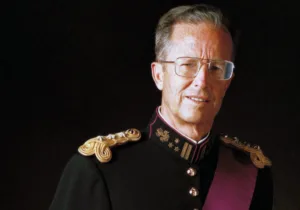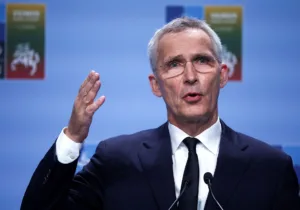Two commentaries recently published in the New York Times by the editors (“Poland’s Tragic Turn,” December 21) and Sylvie Kauffmann (“Stalin’s Lengthening Shadow,” December 23) depict political conflict in Poland as a clash between an authoritarian government, represented by Law and Justice Party (PiS) leader Jarosław Kaczyński, and heroes of a democratic struggle. Kauffmann equates the current political conflict in Poland with Martial Law, introduced in December 1981 by General Jaruzelski of the Communist government to break the “Solidarity” movement. She suggests strongly that on one side of today’s political dispute are those who stood with General Jaruzelski in 1981 against their own nation, and on the other those who heroically fought for freedom.
This is far from the truth. Anyone familiar with recent Polish history knows the role played in the democratic opposition to Communism by figures who now support or participate in Poland’s current government: Antoni Macierewicz and Piotr Naimski (the last surviving founders of the first anti-communist democratic opposition organization, Workers’ Defence Committee, or KOR, a precursor and inspiration for the Solidarity movement), Andrzej Gwiazda and Krzysztof Wyszkowski (founders of Free Trade Unions before 1980, later also joined by young Lech Walesa), or Kornel Morawiecki (founder of Fighting Solidarity). Their services to democracy and the Solidarity movement were no less vital than supporters of today’s radical opposition like Lech Walesa, Adam Michnik, Bogdan Borusewicz, or Władysław Frasyniuk. Today’s divisions in Poland are not as Manichean as presented by Kauffmann. It is not a clash between historical camps of good and evil. It represents is a division within the camp of the heroes of Solidarity.
The Polish Parliament (Sejm) includes, aside from PiS, representatives from four parties, of which only two—the former ruling party, Civic Platform (Platforma Obywatelska), and Modern Party (Nowoczesna)—contest the democratic mandate and legitimacy of PiS. PiS still enjoys, by far, the greatest popular support of any party, as expressed in all opinion polls. Yet the New York Times depicts PiS as a party driven by political revenge, whose sole purpose is authoritarian rule. Is it because Poles are a vengeful people, who seek authoritarianism?
Much of the controversy centers on the Constitutional Tribunal, which many allege had become a political tool of the previous ruling coalition, which appointed 15 of 16 judges, including three in an indisputably illegal manner. It is worth asking how readers of the New York Times might respond were eight of nine Supreme court judges to be appointed by one administration, including two in violation of the law.
The New York Times claims that “the government has cracked down on public gatherings” and that “hundreds of thousands of Poles have taken to the streets”. But this is certainly not the true scale of protests. Even the Polish media, which supports radical opposition, does not speak in such numbers. Whatever the numbers, they demonstrate that the government is certainly not prohibiting public gatherings.
Furthermore, the authors understate the nature of some other protests: an occupation of the Parliament chambers that included seizing by force the seat of the Chairman of the Sejm (lower chamber) and preventing the conduct of business by the parliamentary majority and opposition parties that do not support the radical protest. Imagine how Americans would react if, after losing an election to the House of Representatives, one party were to prevent the other from exercising their right to govern or even debate, by occupying the seat of the Speaker of the House for weeks. Yet in this case, the supposedly “authoritarian” majority did not respond in kind but instead simply moved the deliberations to another chamber.
Most striking about Kaufmann’s commentary is her statement that, of all former Communist countries, Poland has most spectacularly challenged the formula of democracy and the free-market. Not only does such a statement equate the current situation in Poland with Putin’s Russia, but it also suggests that Stalin’s shadow over Poland is now darker than elsewhere. Let’s think about that. Russia is ruled by an elite comprised of former totalitarian political police officials from the KGB, under the aegis of an ex-lieutenant-colonel, Vladimir Putin. During his time in office, free media institutions have been closed (especially television stations), journalists murdered, dozens of people seeking the truth about Stalin’s crimes imprisoned, and dozens of opposition activists such as Anna Politkovskaya, Boris Nemtsov, or Alexander Litvinenko killed.
Such comparisons could have serious consequences if they lead the American people to conclude that Poles or Hungarians or others in East-Central Europe are morally indistinguishable from the regime in Moscow, since all fail to meet the democratic standards of the New York Times, and are therefore worthy to be consigned to the hegemony of Putin.
In Poland, meanwhile, privately run television stations, holding the largest share of the media market, freely express sharp criticism of the government. Kaczyński and his late twin brother in the ruling party, Lech, did not emerge from the KGB but from the democratic opposition. Lech Kaczyński was Lech Walesa’s deputy in Solidarity. From 1976, Jarosław Kaczyński himself was an organizer of KOR. In recent years, there has indeed been one political murder—but not from the current opposition. An associate of the Kaczyńskis’ was shot dead in 2010 by a fanatic under the influence of the media supporting the then-government (and today’s radical opposition) who decided to “solve the problem” of the hated Kaczyński.
Considering today’s political division in Poland, it is worth mentioning that the circle who worked within the Communist secret service structure, the SB (the Polish equivalent of the KGB), opposes Kaczyński’s party. The reason is simple: The current government intends to deprive them of pension privileges granted before 1989. Some 30,000 former officers of the repressive apparatus that introduced Martial Law and suppressed freedom are now among the most dangerous opponents of the current government in Poland and strong allies (thanks to their organizational and mobilization skills) of the radical opposition. This is presented in a highly simplistic way by Kauffman. It is a pity she did not mention this at all.
It is indecent to equate thousands of victims of Putin’s system, who have lost their lives, with the current opposition in Poland—an opposition that occupies the Parliament building in comfortable conditions and enjoys the support of powerful television stations in Poland and elsewhere.
The New York Times writes that Jarosław Kaczyński does not meet foreign journalists. This is belied by lengthy recent interviews with Reuters and Die Welt. The New York Times could easily have checked their facts with the aforementioned former opposition activists who support the current government, including those with perfect command of foreign languages and who know a wide circle of the government representatives, such as President Andrzej Duda, Deputy Prime Minister and Minister of Development and Finance Mateusz Morawiecki, First Deputy Prime Minister and Minister of Culture Piotr Gliński, or at least Poland’s Ambassador to the U.S. Piotr Wilczek. Their contributions might have made the picture of Poland more complicated than presented in these commentaries, but at the same time closer to the truth.
—
Andrzej Nowak, is a professor of History at the Jagiellonian University and the Institute of History at the Polish Academy of Sciences, and a member of the National Development Council at the Chancellery of the President of the Republic of Poland.
Photo Credit: Jarosław Kaczyński speaking at the third anniversary of the funeral of Lech and Maria Kaczynski in Krakow. April 18, 2013. By Piotr Drabik, via Flickr.






 Sponsor a student for Christianity & National Security 2024
Sponsor a student for Christianity & National Security 2024